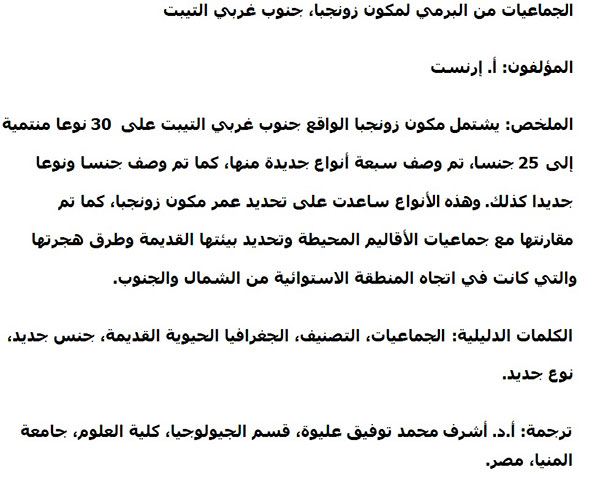Bryozoan fauna from the Permian (Artinskian-Kungurian) Zhongba Formation of southwestern Tibet
Plain Language Abstract
Bryozoans are marine colonial animals and represent a phylum known from the Early Ordovician to the present. The majority of bryozoans produce a stable calcitic skeleton which has a high preservation potential. Therefore, bryozoans have multiple uses for stratigraphy, palaeogeography and palaeoecology. In the present paper an Early Permian bryozoan fauna from the Zhongba Formation of southwestern Tibet is described. The Zhongba Formation was deposited in a relatively deep marine environment of the tropical part of the Tethys. The studied bryozoan fauna includes 30 species from 25 genera. Seven species are new: Fistulipora sakagamii n. sp., Dybowskiella hupehensiformis n. sp., Etherella tibetensis n. sp., Dyscritella lii n. sp., Streblotrypa (Streblotrypa) parviformis n. sp., Timanotrypa australis n. sp., and Protoretepora irregularis n. sp. One new genus with one species is also new: Tibetiporella ornata n. gen. n. sp. The majority of species is known from other regions with faunas of late early Permian age, which is older than the previously defined age of the Zhongba Formation as stated by other fossils like brachiopods (middle – late Permian). Furthermore, the identified species are distributed in such regions as Thailand, Oman, Western Australia, Timor, central Pamir, Iran, Urals, and other Tibetan localities. So far, this fauna shows an intermixture of species from the Northern and Southern Hemispheres, and implies more extensive faunal migrations into the tropical region from both the north and south than previously known.
Resumen en Español
Fauna de briozoos del Pérmico (Artinskiano-Kunguriano) de la Formación Zhongba, sudoeste tibetano
La asociación de briozoos de la Formación Zhongba del sudoeste de Tibet incluye 30 especies de 25 géneros. Siete especies son nuevas: Fistulipora sakagamii sp. n., Dybowskiella hupehensiformis sp. n., Etherella tibetensis sp. n., Dyscritella lii sp. n., Streblotrypa (Streblotrypa) parviformis sp. n., Timanotrypa australis sp. n., y Protoretepora irregularis sp. n. Un género con una especie también es nueva: Tibetiporella ornata gen. n. sp. n. La fauna descripta implica una edad cisuraliana (artinskiana-kunguriana) para la Formación Zhongba y muestra relaciones con las faunas cisuralianas de Tailandia, Australia Occidental, Omán, Timo, Pamir central, Irán, los Urales y otras localidades tibetanas. La fauna de briozoos de la Formación Zhongba muestra una intermezcla de elementos boreales y gondwánicos e implica migraciones faunísticas más intensas hacia la región tropical tanto desde el norte como desde el sur. El análisis paleoecológico sugiere que la depositación de la Formación Zhongba ocurrió en un escenario de plataforma media a cierta distancia de la línea de costa, probablemente influenciada por corrientes locales.
Palabras clave: Bryozoa; taxonomía; paleobiogeografía; género nuevo; especie nueva
Traducción: Diana Elizabeth Fernández
Résumé en Français
La faune de bryozoaires du Permien (Artinskien-Kungurien) de la formation de Zhongba, sud-ouest du Tibet
L'assemblage de bryozoaires de la formation de Zhongba, sud-ouest du Tibet, inclut 30 espèces appartenant à 25 genres. Sept espèces classifiées dans des genres déjà connus sont nouvelles : Fistulipora sakagamii n. sp., Dybowskiella hupehensiformis n. sp., Etherella tibetensis n. sp., Dyscritella lii n. sp., Streblotrypa (Streblotrypa) parviformis n. sp., Timanotrypa australis n. sp., et Protoretepora irregularis n. sp. Une nouvelle espèce appartenant à un nouveau genre est également décrite : Tibetiporella ornata n. gen. n. sp. La faune décrite indique un âge cisuralien (artinskien-kungurien) pour la formation de Zhongba et démontre des relations avec les faunes cisuraliennes de la Thaïlande, de l'Australie occidentale, du Sultanat d'Oman, du Timor, du Pamir central, de l'Iran, de l'Oural, et d'autres localités tibétaines. La faune de bryozoaires de la formation de Zhongba montre un mélange d'éléments boréaux et gondwaniens, et indique des dispersions fauniques fortes vers les régions tropicales à la fois depuis le nord et le sud. L'analyse paléoécologique suggère que la formation de Zhongba s'est déposée dans un milieu de plateforme moyenne, à une certaine distance de la côte, probablement sous l'influence des courants locaux.
Mots-clés : Bryozoa ; taxinomie ; paléobiogéographie ; nouveau genre ; nouvelle espèce
Translator: Antoine Souron
Deutsche Zusammenfassung
Die Bryozoen-Fauna aus der permischen (Artinskium-Kungurium) Zhongba Formation von Südwest-Tibet
Die Bryozoen-Assemblage aus der Zhongba Formation von Südwest-Tibet beinhaltet 30 Arten und 25 Gattungen. Sieben Arten sind neu: Fistulipora sakagamii n. sp., Dybowskiella hupehensiformis n. sp., Etherella tibetensis n. sp., Dyscritella lii n. sp., Streblotrypa (Streblotrypa) parviformis n. sp., Timanotrypa australis n. sp. und Protoretepora irregularis n. sp. Eine Gattung mit einer Art ist ebenfalls neu: Tibetiporella ornata n. gen. n. sp. Die beschriebene Fauna weist auf ein cisurales (Artinskium-Kungurium) Alter der Zhongba Formation hin und zeigt Verwandtschaften mit den cisuralen Faunen von Thailand, Westaustralien, Oman, Timor, Zentral-Pamir, Iran, Ural und anderen tibetischen Fundstellen. Die Bryozoen-Fauna der Zhongba-Formation zeigt eine Mischung aus borealen und gondwanischen Elementen und weist auf eine stärkere Faunen-Migration, sowohl von Norden als auch von Süden, in die tropischen Gebiete hin. Paläoökologische Analysen legen nahe, dass die Zhongba Formation in einiger Entfernung zur Küste an einem mittleren Schelf abgelagert wurde und möglicherweise durch lokale Strömungen beeinflusst war.
Schlüsselwörter: Bryozoa; Taxonomie; Paläobiogeographie; neue Gattung; neue Art
Translator: Eva Gebauer
Arabic

Translator: Ashraf M.T. Elewa

